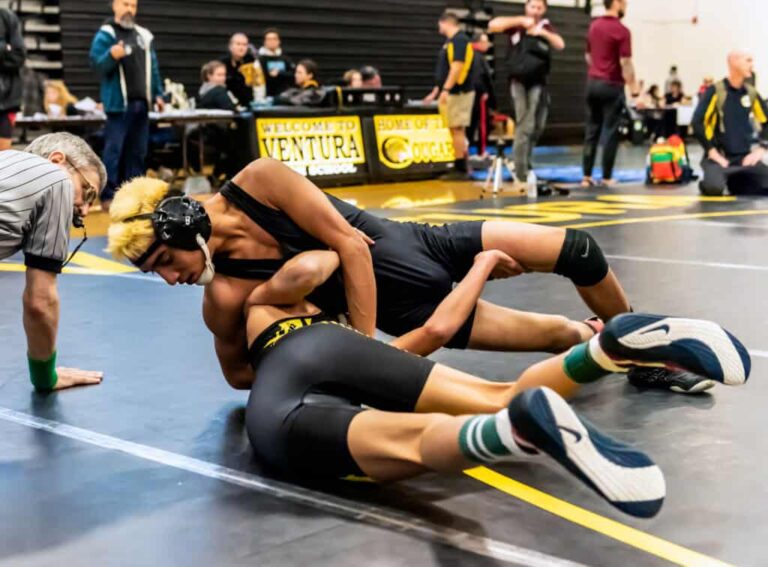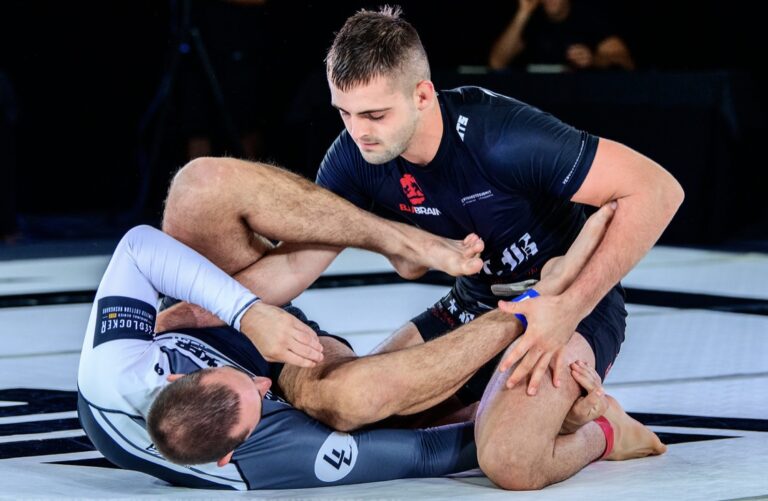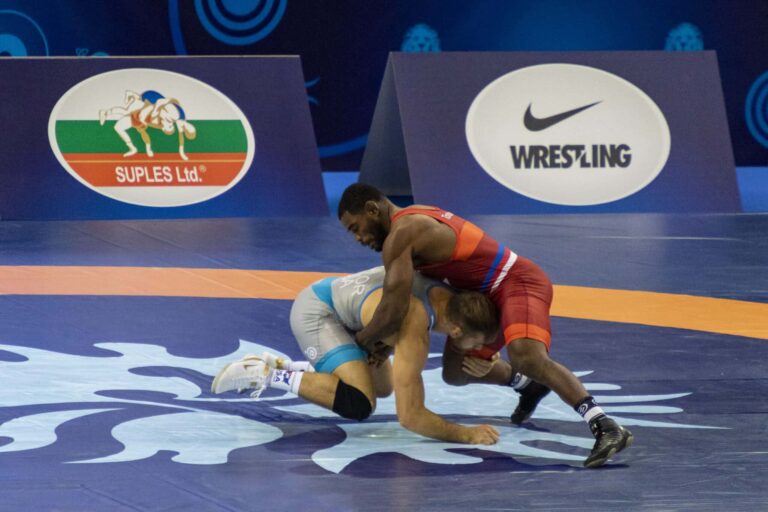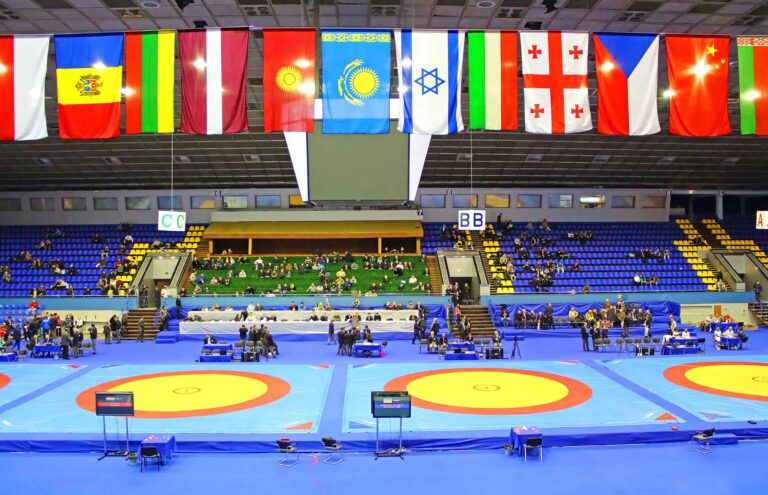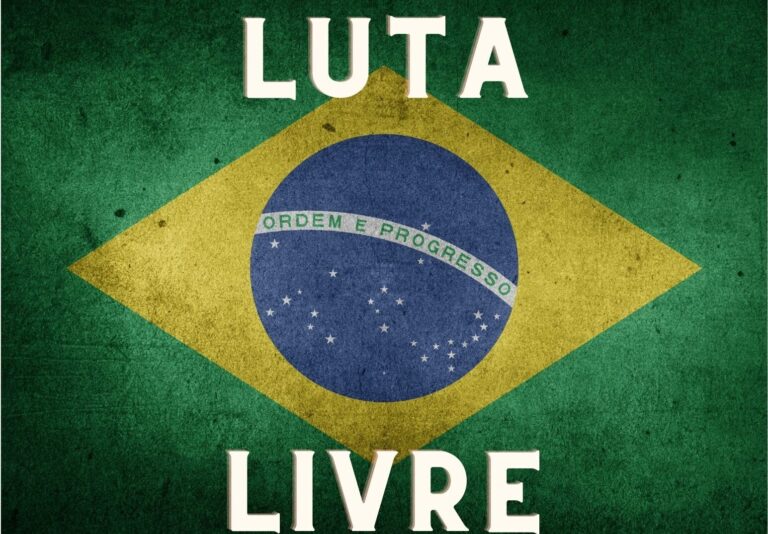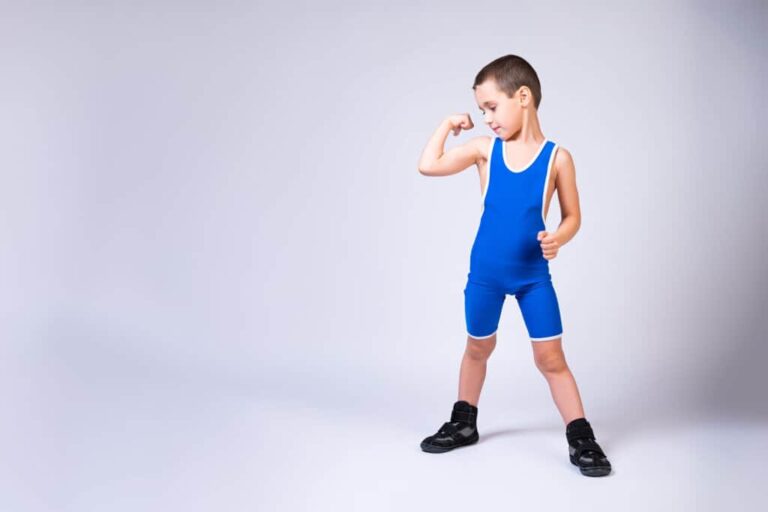Frequently Asked Questions About The Sport Of Wrestling

When it comes to the sport of wrestling people often have a ton of questions. After all, wrestling is a unique sport that has some practices that other sports don’t have. Some of them might even seem a little strange at first until you understand the reasons behind them.
So with that in mind let’s tackle some of the main questions nonwrestlers or new wrestlers have about the sport.
Why Do Wrestlers Have Thick Necks?
You’ve probably noticed that some of your favorite wrestlers have unusually thick necks. They’re powerful, seemingly unshakable, and as sturdy as ever, which leads one to believe there might be a correlation between thick necks and overall strength.
A common characteristic among many wrestlers is their huge and thick necks, A common misconception is that they were born with huge necks, just like most basketballers are born tall.
Wrestlers have thick necks because strong and muscular necks come in handy during bridging when their back is stuck or when they’re finishing takedowns. They are also very crucial in preventing injuries. It relieves them the stress of having to deal with neck pains during the season.
Well, this is true among some wrestlers. They can thank their good genes for their necks; however, many of them spend lots of time and effort exercising their necks. Having a muscular neck has multiple advantages for a wrestler:
- Bridging when the back is stuck
- Finishing takedowns
- Reducing neck stress
- Reducing injuries
- Relieving neck pains
Overall, a strong neck lets a wrestler endure a long season and avoid injuries.
Why Do Wrestlers Spit In A Bottle?
Many people often ask the question: Why do wrestlers spit in a bottle? This is a completely reasonable question to ask seeing as how it is a very strange thing to do. Though it does seem strange, you would assume that there is a reason that wrestlers chew gum and spit into a bottle.
The reason wrestlers chew gum and spit in a bottle is that they are trying to cut weight. If a wrestler is above their weight limit for a competition they might try and spit some weight out. In fact, spitting in a cup is just one way that wrestlers try and cut weight for competition.
Though I am not recommending that someone should cut weight for wrestling, it is certainly something that does happen. That said, there are dangers and health risks that can be associated with cutting weight for wrestling.
As I said, I do not recommend that you do this but I have seen people lose up to 1 lb in a day by simply spitting into a cup. At the end of the day, an ounce is an ounce and a pound is a pound. So if you fill a 16 oz bottle up with spit then it is going to weigh about 16 oz.
Most wrestlers achieve this by avoiding drinking water and then chewing gum and spitting into a bottle. I know this sounds crazy but it is something that many wrestlers do.
How Much Weight Do Wrestlers Cut?
Body mass and physical size factor heavily into all grappling sports because the heavier athlete will typically hold an advantage over their lighter opponent. For this reason, wrestlers will fit within a specific weight class during matches and tournaments. Many wrestlers will drop weight before matches to qualify for lighter-weight classes, but how much weight do wrestlers cut?
Wrestlers may cut between 10-25 pounds (4.54-11.34 kg) of body fat leading up to matches and throughout the season and an additional 5-10 pounds (2.27-4.54 kg) of water weight before weigh-ins. Some wrestlers, however, prefer not to cut much at all to preserve energy.
Of course, many wrestlers take it to the extremes and cut even more water weight. That said, they are taking a big risk to their health. Drastic weight cutting in sports can be very dangerous and in some cases, life-threatening.
Why Are Wrestlers So Strong?

Wrestling is an old sport practiced in various forms all around the world that is known for its strong athletes. Many people get involved in it at school ages and have a lot of dedicated time each day for training. As a result, they develop skills and physical attributes that make them better and better at the sport.
Wrestlers are so strong because they practice strength and weight training, cardiovascular fitness, and good dietary habits. Another reason wrestlers are so strong is that strength helps them to succeed. Without strong muscles and proper technique, a wrestler is unlikely to win.
The main reason wrestlers are so strong is that they highly prioritize strength and conditioning. Wrestlers will spend time in the weight room as an integral part of their training. They engage in specific exercises rather than just lifting heavy stuff and hoping for the best, but weightlifting is an essential part of their success.
Because a big part of wrestling involves trying to move an opponent physically, brute strength is integral, but there are specific muscle groups wrestlers must heed. After all, muscular calves will only get you so far on the mat or in life.
One reason that wrestlers are known to be so strong is that they need full-body strength. Upper body strength gives the wrestler holding and throwing power. Lower body strength gives them the power and strength they need to pick up a move their opponents.
The core and neck muscles get attention, too. The weight training a wrestler undertakes must include these muscle groups because a strong core contributes to and enhances the other groups’ work. The neck muscles need the power to keep the wrestler’s head in the right position throughout a match. Not to mention helping the wrestler avoid injuries.
Because wrestling is such a physically demanding sport, wrestlers need to become strong all over. Sure they might not be trying to get bulging biceps just for the look but a wrestler needs their whole body to be as strong as possible while staying lean.
Does Wrestling Build Muscle?
Wrestling can build muscle like any physical activity. However, the principles of fitness state that to obtain and maintain fitness, you must consistently push yourself to new limits. Additionally, the small amount of muscle gained won’t result in the big physique that you’re going for.
The reason wrestlers are so muscular is because of the strength programs they use to get stronger for wrestling. Wrestling by itself will only put on so much muscle. To put on muscle you need to lift weights and use progressive overload to continue to get stronger.
Progressive overload is achieved by continuously increasing the stress on your muscles. You can do this in a few different ways:
- Adding more repetitions
- Increasing the number of sets per workout
- Increasing resistance or heaviness of weights
Of course, you should always focus on lifting safely and with good form. Don’t just try and increase the weight by any means necessary. Otherwise, you could harm yourself, and you won’t be able to wrestle.
Does Wrestling Get You Ripped?
Wrestling alone might not get you ripped like some of the jacked wrestlers you see in the Olympics. Some people with good genetics can get ripped from wrestling alone but most people will also need to adhere to a strict diet.
Wrestling can help you to gain muscle and lose fat but it might not solely provide the ripped results you’re looking for.
To be ripped means to have both low body fat and a good amount of muscle mass. This is what gives you the ripped and muscular appearance that you’re looking for. Wrestlers have an athletic physique, so we immediately assume that it must be due to the physical act of wrestling.
Wrestling does burn a lot of calories and can certainly help you get ripped. But if you do not control your diet then wrestling alone might not get you ripped.
So think about it this way, wrestlers have strict diets and strength and conditioning programs to help them get lean, muscular, and athletic for wrestling. Instead of thinking wrestlers get lean and muscular only from wrestling itself.
Should Wrestlers Do Deadlifts?
An area that is up for some debate in the world of wrestling is whether wrestlers should do deadlifts. Though most agree that deadlifts are great for building strength, some believe that there is too much risk of injury with deadlifts in a wrestling program.
In my opinion, if a wrestler is well built for doing deadlifts and properly trained then they probably should incorporate deadlifts into their strength and conditioning program. If a wrestler has a hard time doing traditional deadlifts then they might opt for the hex bar deadlift instead. That said, wrestlers are not powerlifters so there is no need for a wrestler to test their one-rep max on a deadlift.
So even though I do believe wrestlers should do deadlifts they do not need to be able to go toe to toe with a powerlifter. Instead, focus on build up your deadlift in the 6-12 repetition range instead.
Of course, if you are unable to perform the deadlift for whatever reason there are some other options. A wrestler does not have to do deadlifts to build the necessary strength. That said, I do believe that the deadlift is one of the best exercises you can do to build real-world strength.
Should Wrestlers Bench Press?
Is The Bench Press A Good Exercise For Wrestlers? This is a topic that has been long debated in the wrestling community. In other grappling arts like BJJ, you often grapple off of your back. So naturally, it makes sense to build pushing strength through exercises like the bench press. But should wrestlers bench press even though they never really fight off their backs?
Yes, the bench press is a great exercise for wrestlers. Even though wrestling involves more pulling than pushing you still need to develop your pushing muscles as well. You still use these muscles when wrestling and it helps you to prevent muscle imbalances.
The truth of the matter is that wrestlers and other athletes need to develop their whole body even if they use some muscle groups more than others. Not only will this help you become a better athlete but it can help you to prevent injuries as well.
Does Wrestling Stunt Your Growth?
Wrestling has become a popular sport in high schools, colleges, and even the Olympics, and more people take it up every year. However, there are some concerns — particularly from parents with young children — that wrestling may stunt their child’s growth, especially if they start wrestling while they’re still young.
Wrestling can stunt a child’s growth, but only if he’s severely restricting his caloric intake to cut into a lower weight class. As long as children don’t limit their calories, stunted growth shouldn’t be a concern. Wrestling can have many physical, mental, and emotional health benefits.
If you are worried about scholastic wrestling stunting your or your child’s growth there are some things you can do to avoid it. Mostly, it is simply a matter of not doing any kind of drastic weight-cutting.
Are You Allowed To Suplex In High School Wrestling?
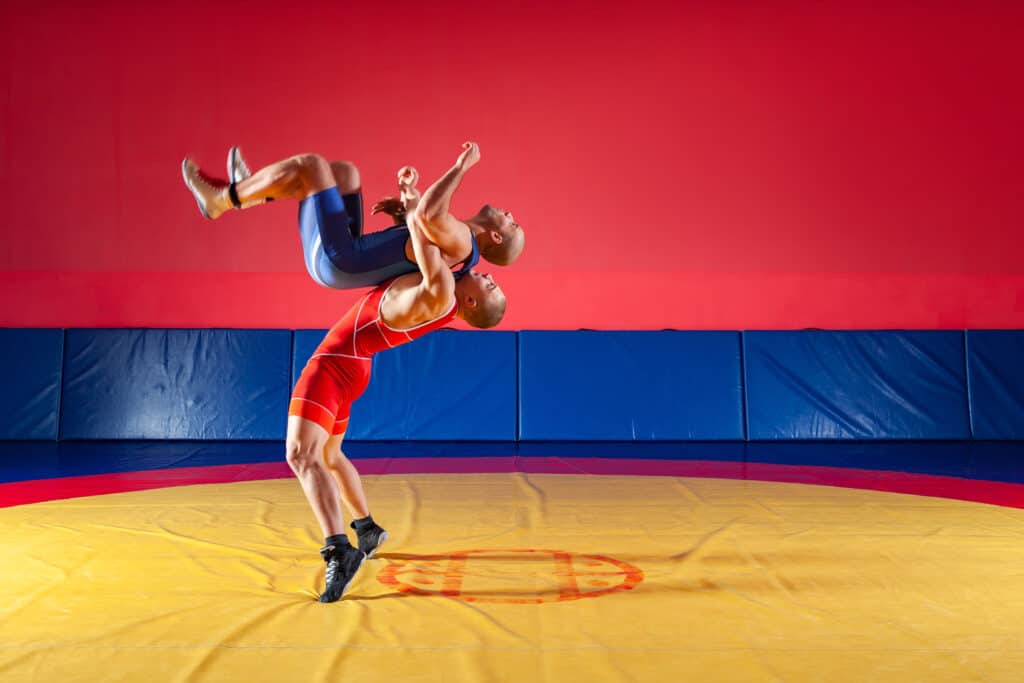
Understanding which moves are allowed could mean the difference between collecting a victory and a loss in high school wrestling. Wrestlers hoping to perfect their techniques may wonder if suplexes are allowed in high school wrestling.
A suplex isn’t allowed in high school wrestling, as it puts wrestlers at risk. If a high school student receiving the suplex lands on their neck, they can suffer severe long-term damage.
Even though suplexes might be allowed in other forms of wrestling such as freestyle wrestling or Greco-roman wrestling, they are illegal in high school wrestling.
Much of this simply has to do with the fact that they have stricter rules to help keep kids safe. Parents would be much less willing to let their kids participate in high school wrestling if it is too dangerous.
So naturally, riskier moves such as the suplex are going looked at more critically when a school board and parents is looking after the safety of their students and kids.
What Takedowns Are Allowed in High School Wrestling?
I do not intend this to be an extensive list of all of the takedowns that are allowed in high school wrestling. Instead, it is simply some of the more common takedowns that are allowed in high school wrestling that can replace the use of a suplex.
- Double Leg Takedown: The double leg takedown is probably the most popular takedown in all grappling sports and MMA. This is simply where you take your opponent down by grabbing behind both legs of your opponent.
- Single Leg Takedown: This is when a wrestler wraps their arms or upper body around their opponent’s leg, then lifts and stands, causing the opponent to fall flat against the mat.
- Hip Throw: This is where you grab your opponent’s upper body and bump them over your hips. Unlike the suplex, you are bumping them over your hips instead of over and behind your body. With this move, it is easier to control where your opponent lands.
- Head and Arm Throw: Similar to the hip throw except that you have one arm wrapped around your opponent’s head and the other holding on to their arm.
- Firemans Carry: This takedown is hard to explain on paper instead check out this video from High School Wrestling Matches on Youtube.
Do You Have To Shave for Wrestling?
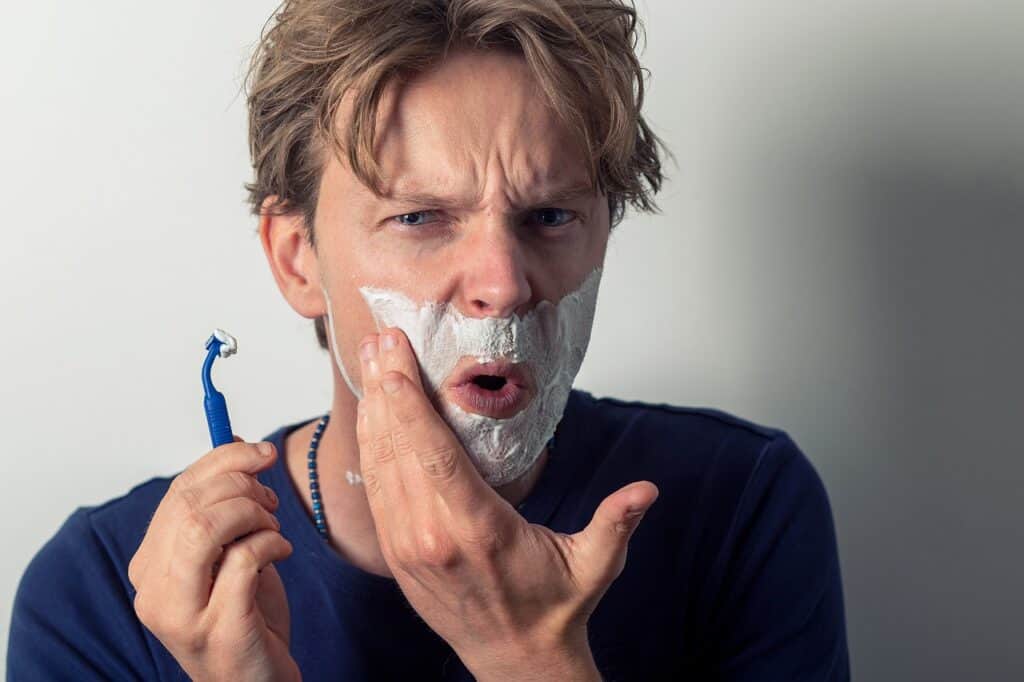
You have to shave for wrestling if your beard is more than half an inch (1.27 cm) in length. If a wrestler’s beard is longer than half an inch, the medical examiner can’t view their skin or perform a proper athletic assessment.
The NCAA Wrestling Committee rules on facial hair state that facial hair for wrestlers must not exceed half an inch in length. The rule exists so that medical examiners can view and examine the skin in case of injury.
If the athlete’s beard exceeds half an inch, a mask or beard cover made from a non-abrasive material is required.
If a medical examiner deems a wrestler’s beard to be too thick for a thorough medical assessment during the contest, they’ll remove the beard.
Which Wrestling Style Forbids the Use of Legs?
There are a few main types of wrestling you are likely to come across, depending on the venue, including folkstyle, Greco-Roman, and freestyle. However, the rules are distinctly different between the styles, with one of the biggest differences being whether or not the use of legs is forbidden.
Greco-Roman wrestling strictly forbids the use of legs. Meanwhile, freestyle wrestling, the other main form of wrestling found at the Olympics, permits the use of legs in its matches, as well as in folkstyle wrestling, also known as scholastic wrestling.
That said, greco-roman wrestling is a very exciting sport to watch. In many ways, it is more exciting because most of the takedowns are high amplitude.
When Was Greco Roman Wrestling Invented?
Greco Roman Wrestling is a popular type of wrestling that’s officially recognized by United World Wrestling. Since the 1908 Olympic games, the combat sport has remained a mainstay in the competition, inspiring the formation of other forms of wrestling. So when was Greco Roman Wrestling invented?
Greco Roman Wrestling was invented in the 19th century, approximately between 1815-1870, and is believed to have borrowed heavily from Roman and classical Greek styles. Jean Exbrayat, a Napoleonic soldier, is credited for the formation of the sport’s basic rules and evolution from other styles.
Greco Roman Wrestling is recognized by Olympics.com as one of the oldest sports to feature as part of the Olympics program. And although the combat sport’s current format was developed in the 19th century, it has a rich history that dates back to the days of ancient Greece.
According to United World Wrestling (UWW), Greco Roman Wrestling was initially formed and developed in ancient Greece, as can be evidenced from a wide array of Greek art and literature. The sport became hugely popular in Greece, especially since it integrated combat fistfights.
The sport remained popular after Rome conquered Greece and mastered its culture. However, the dawn of Christianity in Rome oversaw a steep decline in the sport’s popularity, as gladiator schools and Olympic Games came to a gradual halt.
